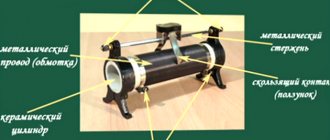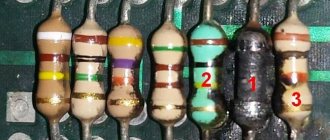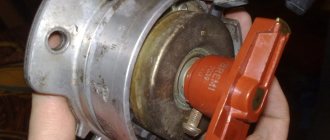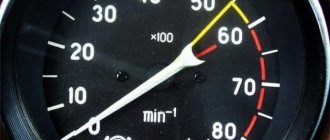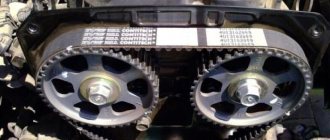Car audio systems rarely use only one full-range speaker. This scheme is used only in exceptional cases, since one loudspeaker gives a satisfactory sound picture, where there are mainly mid frequencies, and the low and high ranges are weak and inexpressive. Component acoustics with two or more acoustic emitters require a crossover.
Typically this is a passive filter using capacitors and inductors that suppresses a certain frequency band. The tweeter limiter attenuates or nearly attenuates all frequencies below 2500 Hz and allows high-frequency content to pass through. The filter, designed to connect the low-frequency head, cuts off frequencies above 150-200 Hz. Thus, the range of reproduced frequencies is divided into two bands designed to work with a specific speaker.
Why do you need a crossover?
There are several types of devices that are needed to protect speakers from overload with non-reproducible frequencies. The main function of crossovers is to filter the range, which improves sound quality.
Device
Equipment is selected depending on the number of bands in the speaker system. The design device consists of frequency filters that are designed to work with low and high frequencies. If the amplifier is three-way, it processes more channels and is also able to filter mid frequencies.
For high-quality sound processing, the crossover contains a capacitor and a coil. The main components contribute to the processing of frequencies that are not suitable for channels. The more reactive parts, the higher the sensitivity of the equipment.
Designations of modifications
Among the designations that crossover modifications for vehicles have are the following:
- Input, or entrance. It is to this place that the output of the active amplifier is connected, so it is important not to make a mistake with the polarity here.
- Woofer, or low frequency emitter. A speaker with mid and low frequencies is connected to this place. Separation stripes are indicated in the technical documentation.
- Twitter, or tweeter. A high-frequency speaker is connected to this location.
These are the main points and rules regarding how to connect crossovers to speakers and to the entire sound system of the vehicle.
Differences between active and passive crossovers
To connect to speakers, a passive type of equipment is often used. This type of device does not require additional power supply, therefore it is easy to install and configure. Sound equipment generates part of the energy that is used to clean up the sound. Reactive parts of passive type equipment have a single-phase shift.
The category of active equipment includes a radio or amplifier with developed sound filters. The design consists of coils, capacitors and semiconductors to amplify the power of small equipment. Rarely used as a separate module. Every car audio system has an active filter.
Where is it placed?
Considering that the crossover cannot be installed in any place, it is worth noting those places that are suitable for installing speakers and amplifiers.
Requirements for installation sites:
- Absence of any leaks or dampness;
- Free and comfortable access for both connection and configuration;
- Excellent air circulation for cooling;
- The absence of any inconvenience or interference that is in any way related to the operation of the vehicle;
- Good visual appearance.
Most often these are places such as:
- Seat backs (rear);
- Rear shelf (the compressor can be located either below or above);
- Under the seats (front);
- Under the trunk floor (if the vehicle design allows this.
Connection diagrams
High-quality car audio is ensured by a correctly selected cutoff frequency. If a three-way crossover is used for acoustics, then in this case 2 cutoff frequencies are determined: 1 - for the difference between low and mid frequencies, 2 - for filtering mid and high frequencies.
The active type of amplifier is a built-in equipment, so to install the stereo system you just need to choose the most suitable place in the car. You can connect the passive one yourself; a simple circuit is used for this:
- It is necessary to install suitable speakers in the car interior.
- Connect the speaker to the device input terminals.
- To connect the crossover to the car speakers, you need to look at the markings.
Speaker input designations:
- Wf - broadband;
- Sw - subwoofer;
- Mw - midwoofer;
- Tw - high frequency.
A simplified connection option is to connect high-frequency speakers with broadband speakers in series. A coil of thin wire is connected parallel to the tweeters. This option allows you to connect tweeters without a crossover.
In this case, the sound of the high-frequency speakers will be enhanced, but the low-frequency and mid-frequency speakers will be slightly attenuated. It all depends on the thickness of the selected wire in the coil. The thinner it is, the higher the resistance will be. An alternative speaker connection scheme will provide natural and high-quality sound to any audio system.
Almost every motorist tries to equip his car with music, but does not always adhere to the rules for installing and connecting speakers. To ensure satisfactory sound quality, it is important not only to choose speakers, but also to know where to install them and how to connect them correctly. If the goal is to independently install a speaker system in a car, then you should familiarize yourself with the possible nuances of this procedure in advance, after which you can begin step-by-step actions.
Installation
Features of how to connect crossovers to speakers include the following:
- Crossovers, as devices that help create the necessary frequencies and sounds on speakers, are connected to the entire audio system;
- All devices, regardless of the type of operation, have symbols located on stickers. Here, on the stickers located on the back, there are diagrams for connecting the active wires;
- After this, the cover is removed, since under it there are indications of the operation and working elements of the device in the general acoustic system of the vehicle;
- The next step is choosing a suitable installation location.
What kind of speakers are there?
Today, almost every car has a radio with speakers located in the front and rear and capable of pleasing the owner with decent sound. The market offers a variety of speaker systems that can satisfy the needs of even the most demanding music lovers. One simple option is to purchase a radio complete with speakers. A more difficult way is to correctly select and install acoustics that will match a specific car.
To get truly high-quality sound, you need to find out what types of dynamic heads exist. They are conventionally divided into:
- broadband;
- coaxial;
- component.
Wideband speakers reproduce the entire spectrum of sound frequencies that human hearing can perceive. It is precisely this kind of acoustics that, in most cases, is equipped with cars from the factory today. If you are a lover of good sound, then preference should be given to coaxial dynamic drivers. The set consists of several columns, the installation of which is carried out along one axis. The entire frequency spectrum, divided into low-frequency (LF), mid-frequency (MF) and high-frequency (HF), is reproduced by separate speakers. By dividing and expanding the frequency range, the sound quality can be improved. For lovers of high-quality music with powerful bass, you should consider a component system, which is usually used as front speakers. In addition to different types of acoustic systems, speakers are divided by standard sizes, the choice of which depends on the installation location and the goals pursued.
All about component acoustics
Local connection of component acoustics
Car acoustics are usually divided into two types:
If coaxial acoustics implies a system with separate HF, LF and MF bands located on the same axis, then component acoustics will allow you to more accurately build a sound stage.
Note. The sound of a component speaker system is always larger than coaxial speakers.
The coaxial system uses a crossover capacitor, which acts as a frequency filter. In component acoustics, this same function is no longer performed by a separate capacitor, but by a whole block with filters of a higher level.
Car radio
Component acoustics naturally consists of individual components. The main role is played by a component called a car radio, which is usually built into the car (see Standard car radios: review and installation).
But usually these are mostly budget options, which are LG or Panasonic cassette players.
If a car owner intends to replace the standard car radio with a CD player, so that the budget does not exceed 2.5 thousand rubles, then it is recommended to pay attention to the following component audio car radios: Pioneer, Alpine and others.
Connection diagram for component acoustics
This is the second component of component acoustics. You have to choose speakers more carefully, giving preference to active subwoofers (see How to make a subwoofer: practical tips), although they are more expensive than passive speakers.
When choosing speakers for your own component acoustics, you should know the following:
- It is necessary to prepare the interior well, carrying out noise and vibration insulation in it.
- Select subwoofers taking into account the purchased car radio.
- It is not recommended to install speakers without acoustic shelves and podiums.
- The speakers can be easily installed in the front doors of the car, regardless of the size of the speakers.
An external power amplifier significantly improves the quality of the music being played. In active speakers it is already built in by default, but for passive speakers it must be purchased separately.
How to connect speakers to a car radio
Before you begin installing and connecting the speakers, you need to decide on the location of their installation. Depending on the vehicle, there may be space provided for the speakers from the factory. It is recommended to mount the front speakers on the edges of the dashboard or in the doors. Both options are good, but the second is the most popular, since the dynamic heads can be secured more reliably. In addition, an acoustic podium can be built into the door body. The diameter of the columns must be measured, after which the dimensions are transferred to the doors, for example, with a sharp knife. It is advisable to use patterns to transfer dimensions.
As for the second pair of speakers, they are located in the rear of the cabin. Basically, the rear shelf or doors are used for these purposes. In any case, installation requires some modifications. The standard shelf of the car is a decorative element and to install the speakers you will need to remove it and install speakers with podiums. Only in this case can you count on high-quality sound and the absence of squeaks, rattles, etc.
Wire selection
To connect speakers, it is recommended to use speaker wires with a cross-section of 1.5–4 mm². Despite the fact that compared to a radio and speakers they are low in cost, their quality should not be neglected. First of all, you need to know and take into account that the wires that come with the speaker system are unsuitable for normal operation of the speakers: they have a cross-section of 0.25–0.5 mm². Such wiring will be sufficient only for connecting low-power dynamic heads (up to 15–20 W). The thing is that the RF signal in the wire spreads across its surface. Using wires of small cross-section, not only the quality, but also the volume of the sound deteriorates.
Speaker wires should be selected with a cross-section of 1.5–4 mm², which depends on the signal strength. You should not use the wires that come with the speakers due to their small cross-section, which will negatively affect the sound quality
It is also necessary to take into account the fact that the speaker wires are marked, can have either two or four pairs, be plain or with a black stripe. The connection of a single-color conductor is made with a wide contact of the speaker, with a black marking - with a narrow one. If the acoustics have low power (up to 20 W), then the minus for the side and rear speakers can be used. For higher power systems, “+” and “-” must be supplied to each speaker separately, while the negative wire cannot be connected to the car body. Otherwise, the sound will be distorted. The main materials used for making acoustic wire cores are copper and aluminum. It is preferable to use copper, since it oxidizes less on connections, but it is also more expensive compared to aluminum. There are also more expensive wires - silver.
The speaker has positive and negative terminals that differ in size. When connecting, you must observe polarity
Soundproofing doors
When deciding to install speakers in the door, you should take into account that it will not be possible to achieve good sound without sound insulation. In this case, the following conditions must be met:
- carry out measures aimed at vibration isolation of doors, which will avoid rattling when playing low frequencies;
- a closed volume is made inside the door, which will provide detailed sound;
- the speaker is securely fixed to the surface of the door;
- soundproof the door to reduce noise levels from outside;
- they carry out treatment against vibrations and squeaks of the door trim, which will avoid rattling and overtones when listening to music loudly.
During installation work, one must strive to preserve both the appearance of the interior and the integrity of the trim, which requires care when removing the trim material. Standard speakers are attached directly to the trim. This option is not correct, since the required rigidity is not provided. The casing sways during sound, overtones and resonance are created, and the response to the low frequencies decreases. To achieve the required level of vibration and noise insulation, a Bimast spacer is applied to the outer part of the door body. The section of metal located opposite the hole for the standard dynamic head is covered with bitoplast to avoid standing waves.
In order for the sound to be of high quality, it is imperative to prepare the doors, namely soundproof them. This process will avoid rattling, squeaking and extraneous noise.
Tools and materials
To install the speakers you will need the following tools and materials:
- high quality speaker cable;
- plastic and rubber corrugation;
- multimeter;
- insulating material;
- drill and drill bits;
- spacer rings;
- wire cutters;
- Screwdriver Set.
How to lay wires
If the doors do not have holes for laying wires, make them yourself, while avoiding contact between the wire insulation and metal or plastic. For these purposes, special rings or rubber corrugation are used. To lay the cable to the rear speakers, it is most convenient to place the wires parallel to the standard wiring, which will require removing the decorative interior trim and disassembling the dashboard. The procedure is labor-intensive, but it is better to do everything wisely right away than to later face possible problems by laying wires, for example, under a rug.
Purpose
The main purpose of installing tweeters is to reproduce high frequencies. They are small speakers that are installed in the front and rear of the car (or in one of them), depending on the audio system. For maximum effect, they are used as part of multi-component audio systems, but can be found in retail sales (for example, from Pioneer). The advantages of the speakers include ease of installation - every car owner can connect the tweeters correctly.
Speakers for better sound
When installed in speaker systems, motorists install tweeters through a crossover - this is a device that provides operating ranges for the speakers. It separates frequencies when working with a multi-component audio system. This allows you to get the maximum effect from the system and ensure high-quality sound quality in the car.
Connecting tweeters to the crossover is quite simple, and to do this, you only need to read the audio system instructions. But there are times when you need to connect the tweeters in your car directly to the radio.
Connecting tweeters to the radio
Attention: installing tweeters without a crossover or other filters may affect the sound quality! The signal coming out of the radio is the same and will not be distributed across frequencies. It is not recommended to connect speakers this way, but it is possible.
It is possible to connect tweeters to speakers that are already installed. To do this, you will need a 1st order filter (capacitor). The capacity will depend on the installed speakers and is selected individually in each specific case.
Connection rules
Component Audio Source Locations
The sound quality of coaxial speakers satisfies most motorists, but not all. The design disadvantage of coaxial sound is that high-frequency tweeters are placed in inaccessible places along with the front speakers. To overcome this disadvantage, component systems with speakers spaced apart in space are used.
Due to the layout of car interiors, it is difficult to choose the ideal location for tweeters. The most acceptable compromise between price and quality is to place the low- and mid-frequency speakers in their standard place and move the high-frequency drivers to the dashboard or the A-pillar.
Connecting tweeters
The installation procedure for component speakers is given below:
- With the battery turned off, install the crossovers in a place protected from dust, moisture and vibration.
Connect the crossover filters directly to the output of the radio. Place the wires under the casing. When installing crossovers, make sure that they are reliably protected from dust, moisture and vibration - Connect the tweeters to the crossovers using a temporary circuit without fastening.
- If there are no crossovers, connect the high-frequency speakers in parallel with the main ones through a capacitor connected to the open circuit (do not use an electrolytic one) with a capacity of about 1–1.5 μF.
- Apply power and select the most suitable location for mounting the tweeters, based on sound quality. Disconnect the battery.
- If necessary, drill holes in the panel for tweeters.
If using cabinet speakers, mount them in the chosen location, route the wires and connect them to the crossovers. If you decide to use cabinet speakers, securely attach them to the corners of the dashboard
Requirements before connecting
To properly install tweeters in a car, you need to perform a number of steps before installation:
- Select the locations where the speakers will be installed. Due to their size, they are most often installed in doors, along the edges of the dashboard or on windshield pillars. Installation in doors is more popular due to the possibility of installing an acoustic podium.
- Measure the size of the speakers and transfer the dimensions to the installation site. If double-sided tape is enough for installation on the dashboard, then precision and new holes will be required to install the speakers in the doors.
- Pick up the wires. Sometimes this is not required, and the kit comes with cables with a suitable cross-section (the optimal one is 1.5-4mm 2 ), but in most cases, the speaker kit comes with wires that are unsuitable for stable operation of additional speakers (0.25-0.5mm 2 ). If you do not select new cables, this may not only result in poor sound and sound distortion, but also a short circuit in the future. It is recommended to use copper wires during installation.
- It is required to soundproof the doors (if they are selected for installation). This is done to improve the sound quality of the speakers. Removing the casing and other actions must be done as carefully as possible so as not to damage anything.
Installation and connection
To complete the installation and install the speakers, you need to do the following (installation in doors is taken as an example):
- After removing the door trim, a hole of the appropriate diameter is made in the place where the column will be installed.
- Next you need to lay the wires. If there are no holes for them, you need to make them yourself using a drill. It is necessary to prevent contact of the cable with metal parts of the car (for this you need to use corrugation or spacer rings). In most cases, the wires are laid parallel to the standard wiring - this avoids problems in the future and achieves maximum safety. It is necessary to lay the wires in the doors so that when the door is opened and closed, the cable rotates and does not bend. After wiring the wires, you need to check with a multimeter for short circuits (measure the resistance, which should be 3-4 ohms).
- The speaker is attached to the casing using double-sided tape.
- After completing all the steps described above, you need to correctly connect the speakers to the system. It must be remembered that different connection methods are possible, but it is recommended to connect the speakers to a crossover or frequency filter in order to achieve the best sound. Another recommended method is to connect through an amplifier. You will need to run wires from it to the tweeters. The connection must be made only according to the connection diagrams (depending on the method) and not deviate from them.
- It is necessary to check the operation of the equipment and configure it. If everything is done correctly, the devices will work normally.
- Reinstall the disassembled parts and secure them.
Attention: during installation it is necessary to mark the wires so as not to get tangled in them, properly insulate all contacts and take the cable with a small margin!
Bottom line: installing tweeters in a car is not difficult and any car owner can do it. But if you don’t have the relevant experience, and you don’t have enough time to study the installation yourself, or you have doubts about success, it’s better to turn to specialists or a car service center.
“>

